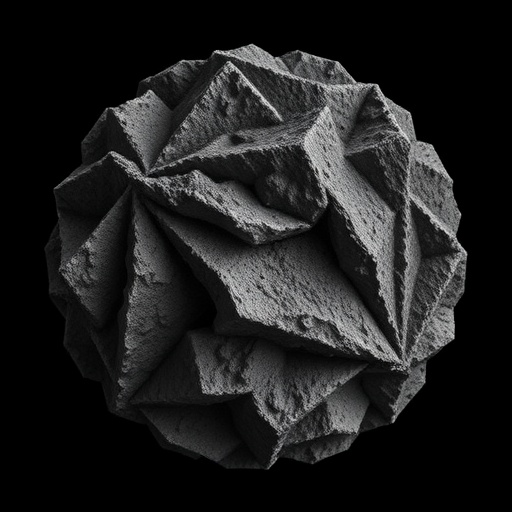In recent explorations of coal’s intrinsic properties, a groundbreaking study has emerged that leverages modern imaging technologies to delve deeper into the microstructural complexities of this critical fossil fuel. Researchers led by Zhang, K., have harnessed the power of micro-computed tomography (micro-CT) imaging to unveil the intricate architectures that characterize coal at a scale much finer than previously imaginable. This innovative approach is grounded in the principles of fractal geometrical theory, enabling the team to draw connections between coal’s microstructure and its physical and chemical behaviors.
Coal has long been recognized not only for its energy content but also for its complex geological formation processes, which manifest themselves in various microstructural features. Traditional characterization methods have offered only a limited scope of understanding, often overlooking the nuanced complexities that can significantly influence coal’s performance in energy production and other applications. By utilizing micro-CT imaging, the researchers have stepped into a realm where detailed visualizations can reveal the interconnected networks and fractal-like patterns prevalent within coal samples.
The study makes a compelling case for the application of fractal geometrical principles as a lens through which to examine coal’s microstructure. Fractals, characterized by their self-similarity and intricate scaling properties, align well with the observed structures within coal, suggesting that such patterns are not merely incidental but fundamental to understanding mineral behavior. This perspective not only provides theoretical insights but also practical implications for predicting how coal might react under various conditions, such as combustion or gasification.
The micro-CT method employed in this study allows for high-resolution imaging that captures the porous nature of coal with exceptional clarity. By analyzing these images, the researchers can quantify critical parameters such as pore size distribution, connectivity, and surface area—all of which are pivotal when considering coal’s efficiency in energy conversion processes. Understanding these parameters can guide industry practices, making resource extraction and utilization strategies more effective and environmentally sustainable.
As part of their investigation, the research team extracted fractal dimensions from the micro-CT images, illustrating how these dimensions correlate with coal’s physical properties. The fractal dimension quantifies the degree of complexity within the microstructure, offering a numerical way to compare samples and predict their behavior. This connection opens new avenues for using fractal analysis as a predictive tool in coal science, potentially revolutionizing how coal deposits are evaluated and utilized.
Moreover, the implications of this research extend beyond coal. The methodologies and theoretical frameworks established here could be applicable to other natural resources where understanding the microstructural characteristics plays a crucial role. For instance, the oil and gas industries might benefit from similar approaches to better characterize reservoir rocks or the biomaterials sector could find relevance in studying the microstructures of biological tissues.
Another significant aspect of this work is its potential impact on the environmental discourse surrounding fossil fuels. By providing a clearer picture of coal’s microstructural intricacies, the study equips stakeholders with the knowledge to assess the viability of cleaner technologies that can mitigate the environmental impact of coal consumption. The insights gained from understanding coal’s complex geometry could lead to improved methods for carbon capture and storage, which remains an essential strategy in efforts to combat climate change.
Furthermore, the remarkable detail offered by micro-CT imaging enables researchers to visualize and understand the aging processes of coal. The way coal evolves chemically and physically over time has critical implications, particularly as we consider the sustainability of our energy sources. By comprehending how microstructural changes occur within coal deposits, scientists can foster better long-term strategies for energy resource management.
The findings of this research echo a broader trend within material science towards employing advanced imaging and analytical techniques to unveil the hidden complexities of materials. Such innovations inspire a shift in how researchers approach conventional materials, urging a deeper examination of their structural attributes. The integration of fractal geometrical theory into this discourse not only enriches our understanding but also encourages interdisciplinary collaborations across geology, physics, and engineering.
As efforts to transition to cleaner energy sources continue to ramp up globally, understanding the nuanced aspects of coal’s microstructure through advanced imaging techniques becomes increasingly relevant. The research conducted by Zhang et al. highlights the need for a nuanced appreciation of coal, recognizing it not merely as an energy source but as a material with complex properties that require sophisticated analytical methods for proper characterization.
In conclusion, the innovative approach taken by researchers to marry micro-CT imaging with fractal geometrical theory stands as a testament to the evolving landscape of coal research. By unveiling the layers of complexity embedded within coal’s microstructure, the study paves the way for more informed practices in energy production. This research not only enriches our knowledge of coal but also sets a precedent for how similar methodologies can be applied across various fields to advance our understanding of material sciences.
As the dialogue surrounding fossil fuels continues, such studies remind us of the intricacies inherent in natural resources. A nuanced understanding rooted in rigorous scientific inquiry is essential, not only for the preservation of these resources but for navigating the complex terrain of energy consumption in the face of climate change.
Subject of Research: Microstructure Complexity in Coal through Fractal Geometrical Theory
Article Title: Micro-CT Image-Based Characterization of Microstructure Complexity in Coal: From the Perspective of Fractal Geometrical Theory
Article References:
Zhang, K., Xing, X., Wang, L. et al. Micro-CT Image-Based Characterization of Microstructure Complexity in Coal: From the Perspective of Fractal Geometrical Theory.
Nat Resour Res (2025). https://doi.org/10.1007/s11053-025-10516-8
Image Credits: AI Generated
DOI: 10.1007/s11053-025-10516-8
Keywords: Micro-CT, coal, fractal geometrical theory, microstructure, image analysis, environmental impact




